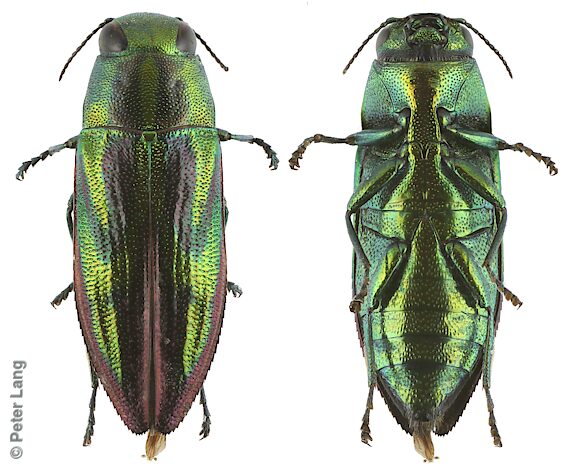Similar to M. splendida but differs noticeably in its more elongate shape, and the elytra often have a greater extent of maroon/purple coloration and narrower green/blue vittae.
Melobasis purpurascens appears to be an uncommon species in South Australia and restricted to areas of higher rainfall, although there is a 1936 collection labelled with the general locality of Yorke Peninsula. As with M. splendida, it can be difficult to separate from Melobasis innocua without male genitalia, and there is a possibility that specimens from the lower SE region, at least, may be that species.
| Legend | records | count of breeding adults, pupae and larvae |
| sites | count of major sites (unique 10 km grid cells +/- some distinct approximate localities) |
| adult | live = extracted alive; dead = extracted dead as intact or fragmentary remains; ex billet = reared and emerged from stored sections of host; ex pupa = reared from sampled pupa |
| pupa | extracted pupa; pupa ex larva = reared pupa from larva |
| larva | extracted larva (any stage including prepupa) |
| gall (only) | hatched or unhatched gall identified by form and position rather than contents |
| Plant names in green are hyperlinked to a matching host species page with plant photos. |
A review of host plant records for M. purpurascens by Hawkeswood 2006b lists a variety of larval hosts, including the following species which also occur SA: *Acacia dealbata, *A. longifolia ssp. longifolia, A. l. ssp. sophorae, A. melanoxylon, and *Citrus spp. (cultivated). The new SA breeding record presented here was obtained from Bryan Haywood who reared two adults in billets of Myrtle Wattle Acacia myrtifolia south of Mount Gambier.
None of the other SA records include host plant details, but interstate adults have been caught on: Banksia marginata, Acacia longifolia ssp. longifolia, A. melanoxylon, Leptospermum spp. and Ozothamnus ferrugineus (Hawkeswood 2006b; Bellamy et al. 2013). All the larval and adult host records need to be considered with caution due to the difficulties with identification in this species group.
| ¹ Legend | regions | SA State Herbarium regions (map)
EA: Eastern, EP: Eyre Peninsula, FR: Flinders Ranges, GT: Gairdner-Torrens, KI: Kangaroo Island, LE: Lake Eyre, MU: Murray, NL: Northern Lofty, NU: Nullarbor, NW: North-Western, SE: South-Eastern, SL: Southern Lofty, YP: Yorke Peninsula |
| size | The ellipse is the correct size when printed, indicative on a desktop screen, and likely to be wrong on a mobile device. |

